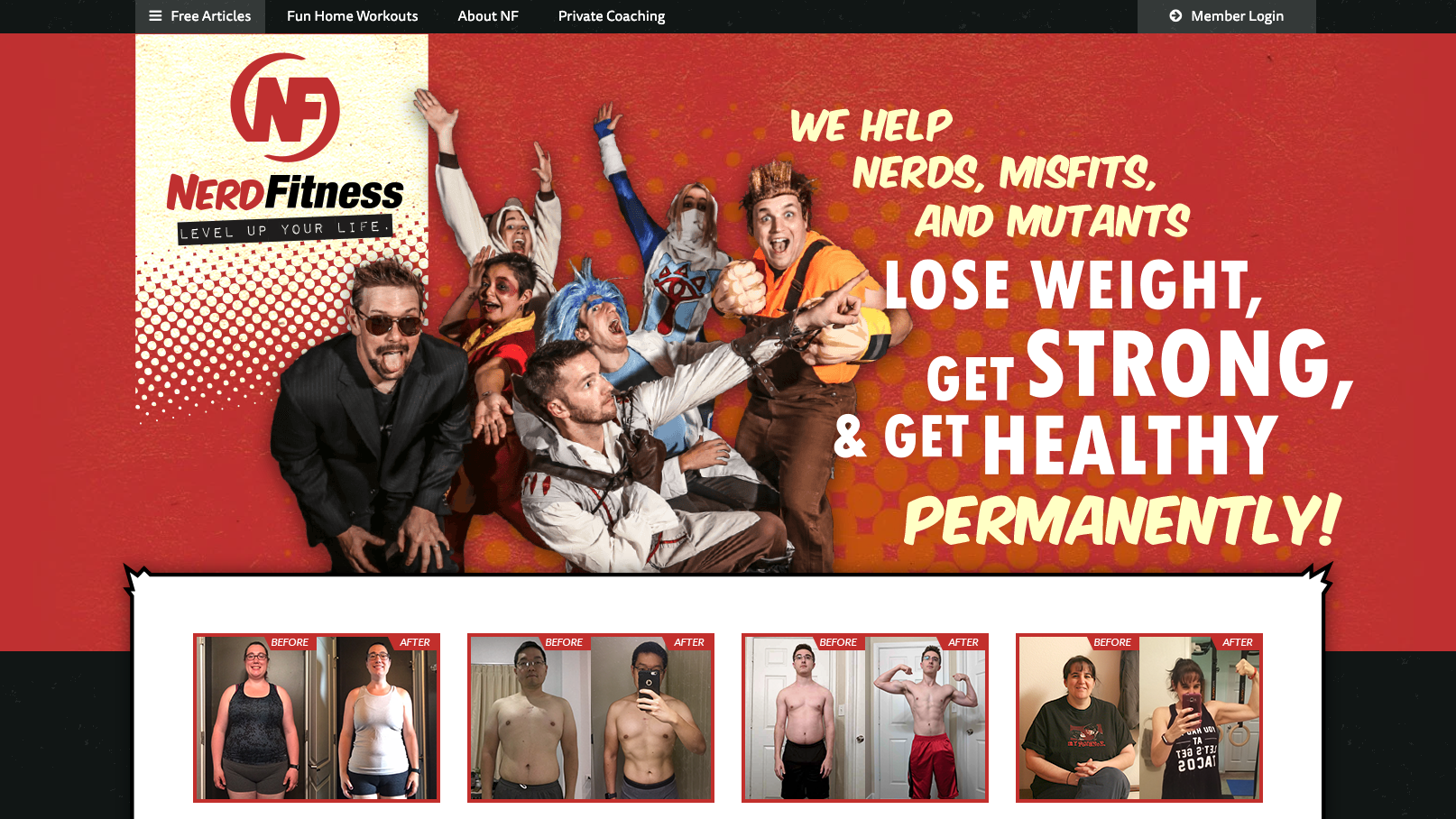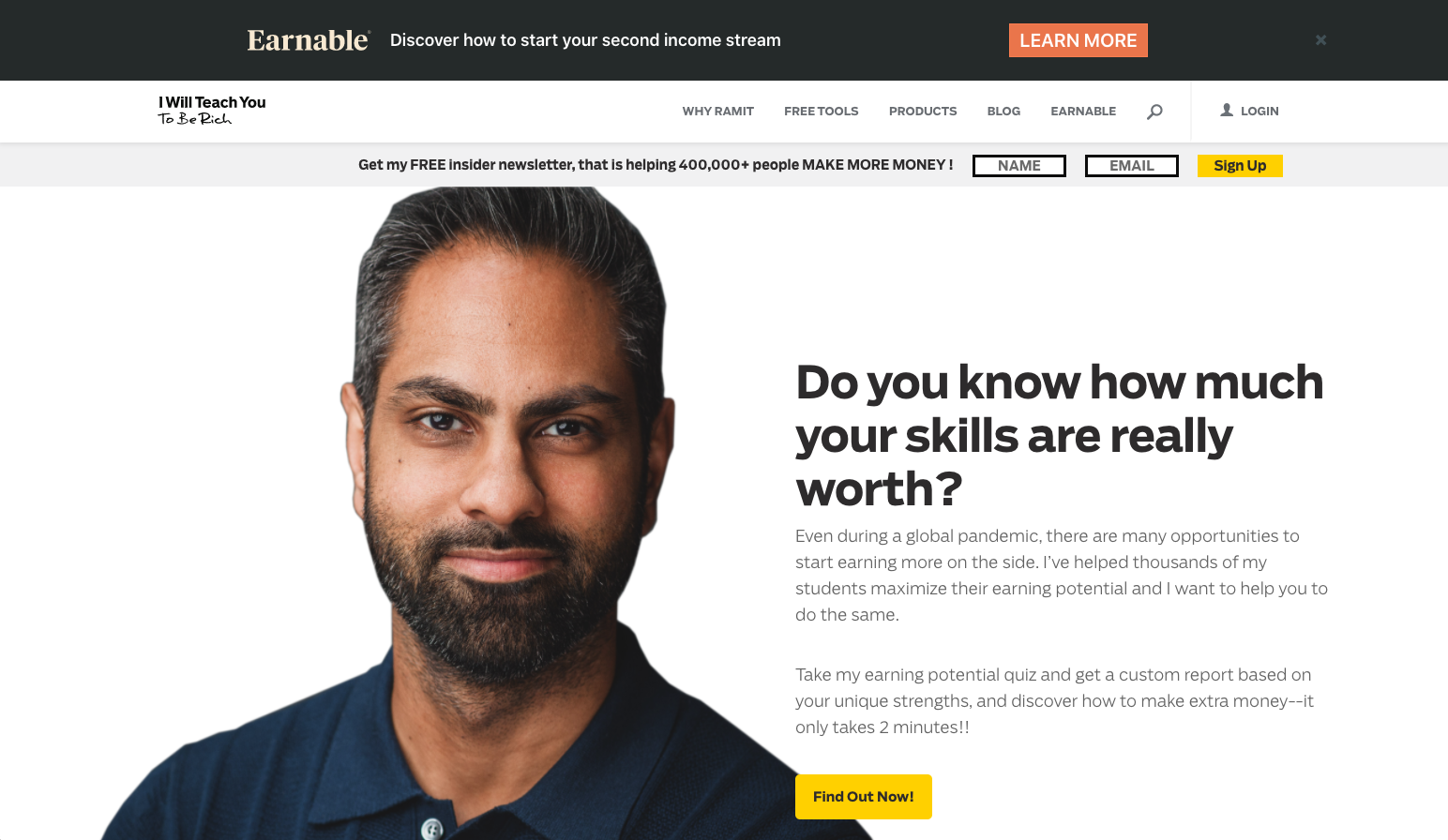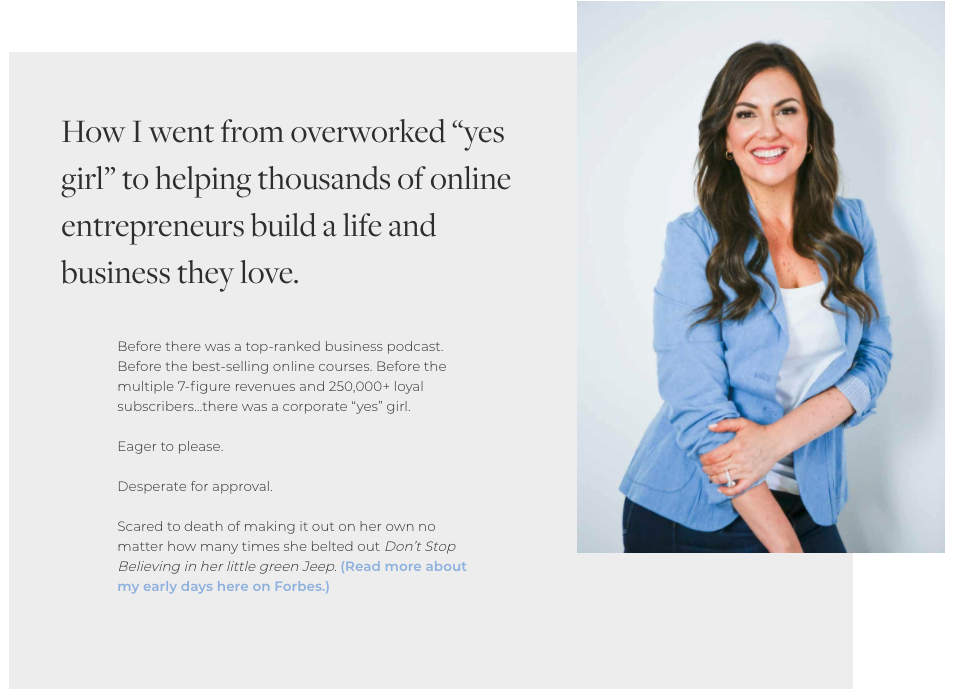Blogging can be a great way to make money.
Not only does it allow you to flex your creative muscles, but it also gives you a chance to generate cash on the side (or full-time).
The best part: A TON of people make money from their blogs already. That means you can use their proven methods to turn your blog into a money generating machine.
With so many bloggers out there, it’s hard to figure out how they did it.
Luckily, we’ve created this list of 23 bloggers who run successful blogs—and how you can too.
23 People Who Make Money Blogging (and How You Can Too)
I have a major disclaimer before we begin: I’ve worked with a few people on this list.
In fact, I was personally responsible for setting annual revenue goals and hitting those goals while I was the Senior Director of Growth and Product at I Will Teach You To Be Rich.
In that case, specifically, I’m extremely familiar with revenue totals and what drove that revenue.
Not to mention the affiliate commissions paid out to some of the people on this list, numbers that were shared in confidence after a few too many drinks, and second-hand rumors that I picked up along the way.
I’ve got sad news: I’m not going to share any of that insider knowledge. Sorry.
I take the trust and confidence people have put in me very seriously. So I’m only going to be sharing revenue numbers that have been shared publicly.
There are some common rules of thumb for figuring out revenue, though. They’re not perfect rules but they do tend to get the right number of digits. And after a while, you get a general sense of people’s revenue based on the size of their audience.
Marie Forleo — marieforleo.com
Revenue = Roughly several million per year
Marie has been writing online for nearly 20 years now.
She also put in a lot of work into her YouTube channel.
Her content has a great reputation and her copy is world-class. I assume most of her revenue comes from infoproducts, particularly her flagship program B-School, which is sold out every time I check on it.
She’s an amazing person to study if you want to learn how to produce high-quality positive content.
She’s also brilliant at balancing valuable content with going for the sale in an authentic way.
Steve Kamb — Nerd Fitness
Revenue = Over $1 million per year
According to a report from Forbes, Steve makes more than seven figures from Nerd Fitness. The business offers infoproducts, coaching, and bootcamps. Steve also wrote a book called Level Up Your Life.
The best part about Steve’s blog is how he’s using a broad, competitive category (fitness) but targeting a very specific audience (nerds). The fitness space is crazy competitive but by branding his entire business around fitness for nerds, he clearly separates himself from that competition. Even in the most competitive categories, there are still opportunities to target a niche with your blog and make real money with it.
Ramit Sethi — I Will Teach You To Be Rich
Revenue = Can’t tell you
Ramit Sethi is the author of NYT best seller I Will Teach You to Be Rich. His website of the same name delivers infoproducts (ebooks, online courses, webinars, etc) about personal finance, entrepreneurship, and personal development.
Ramit is absolutely at the top of his game when it comes to infoproducts. This is a great site to follow and research if you’re considering monetizing your own blog with infoproducts.
Make sure to sign up for his email list—you’ll start getting the launch funnels and you’ll be able to see how it all works.
Products are available for purchase from the products page. That’s a great source for inspiration to see what an amazing infoproduct sales page looks like.
Amy Porterfield — amyporterfield.com
Revenue = At least $2–3 million per year (maybe more)
Amy’s about page states that she’s built a multi-million dollar business. That’s not hard to believe with more than 250,000 loyal email subscribers.
I’m assuming that the vast majority of her revenue is from her infoproducts, but it looks like she does some affiliate promotion too. Her affiliate page is pretty classy and well done. It’s a great example of how to promote products in an authentic and non-pushy way.
She also has a podcast that she can use to draw in more customers as well as leverage podcasting ad revenue. This is a great example of using multiple revenue streams to great effect.
Jon Morrow — Smart Blogger
Revenue = Over $1.2 million per year
In this post, Jon states that he’s doing over $100K per month in affiliate revenue which is pretty impressive.
He also has several of infoproducts in the form of courses, ebooks, and videos available for purchase on his site. I bet these do about $30–50K per year on their own. I’m not sure what Jon’s email funnels look like but if he’s pushing launch funnels aggressively, he could easily have another few million in revenue from infoproducts on top of his affiliate revenue.
Darren Rowse — Problogger
Revenue = My guess is about $10 million per year
Problogger has been around since 2004. That’s an eternity in online marketing. It’s one of the original “how to blog” blogs. Darren also owns Digital Photography School which has 8X as much traffic and revenue as Problogger.
Darren did do an income report on the first half of 2016. At that time, 46% of his revenue from both sites came from affiliates, 31% came from infoproducts, and the rest from a smattering of different categories.
Seth Godin — seths.blog
Revenue = My guess is over $2 million per year
Seth Godin had plenty of success before his blog: he’s written 18 books, built and sold a company to Yahoo, and then was a VP at Yahoo. And his blog has cemented him as the leading marketing thought leader. If you were trying to come up with an ideal example of a thought leader, you’d have a hard time finding a better example than Seth Godin.
Seth’s blog is the original, longest-running, and possibly highest-value blog in marketing. He’s posted every day for like 20 years or something.
For a long time, he never monetized it—but he did use it to feature his books occasionally. More recently, he has done a few infoproducts including the altMBA and The Marketing Seminar. I went through The Marketing Seminar myself and quite a few people were in the community, so it sold well. Seth’s site says that over 5,000 people took the course in total. At $800 per sale, that’s about $4 million in total spread over several years. Plus all the revenue from altMBA.
Neil Patel — neilpatel.com
Revenue = I’m not even going to guess
I worked for Neil when he was a co-founder of KISSmetrics. I also worked with him on some other projects after that. I’m not going to even hazard a revenue guess here since I don’t want to reveal anything that Neil would prefer to keep private.
That said, there are a few things you could look to to figure it out. He has stated publicly that his main site, neilpatel.com, generates over 2.5 million visitors per month. I’ll let you figure out the revenue from there.
Neil is passionate about helping people start their own business. If you visit his site, you’ll find a wealth of knowledge about how to use social media and blogging to drive traffic to your site. He’s constantly updating his posts, so you can find out the latest tools and strategies.
Given his success, taking a page out of Neil’s book is not a bad idea.
Selena Soo — selenasoo.com
Revenue = Over $1.6 million per year
In this article, Selena reported that she made $1.6 million in 2017. I assume the majority of her revenue comes from infoproducts that she launches to her email list periodically.
She’s built out a pretty impressive infoproduct portfolio along with some higher ticket mastermind offers. Overall, very impressive.
Sam Dogen — Financial Samurai
Revenue = My guess is about $1 million per year
Sam gives a few hints on what he makes with his site. First, he does give the revenue of his infoproduct ebook which is $36,000 per year.
Funny enough, he chooses not to include his Adsense revenue or affiliate revenue as “passive” income within any of his passive income reports. Most folks in the industry would consider these revenue sources to be passive (though there’s no question it takes a lot of upfront and maintenance work).
Sam does break down some hypothetical revenue amounts of blogs of different sizes here. One example includes a personal finance blog that’s generating about one million visitors per month. I remember Sam stating somewhere along the line that he has about that much traffic. The traffic estimation tools like Ahrefs also put his site in the range. So, the example that he gives should be close to his actuals. Using his projections as a guide and knowing that he has plenty of affiliate links along with Adsense on his site, a $1 million per year estimate should be close.
Brian Dean — Backlinko
Revenue = Over $1 million per year
Brian offers infoproducts to his newsletter subscribers. He also has a course on SEO and one on YouTube.
He gets plenty of traffic. So each launch should be doing somewhere in the upper six figures, possibly $1 million per launch.
He has stated in a few interviews like this one that he’s doing seven figures per year.

This is a great example of a business that’s focused really heavily on generating traffic, turning that traffic into email subscribers, then monetizing via a few infoproduct launches per year.
It can seem magical to have a business with ridiculous profit margins at this stage. Most of us would love to have a $1 million per year business with a super small team and a handful of moving pieces.
James Dahle — White Coat Investor
Revenue = Over $1 million per year
James used to publish his annual revenue in his annual state of the blog posts but stopped as his blog became more well known. Here’s his 2019 state of the blog. His last reported income was $187,862 in 2014. He does mention multiple times that he’s now running a seven-figure business, so his current revenue is at least $1 million per year.
He does have a book by the same name. Looking through his site, the majority of his revenue comes from affiliates, ads, and sponsorships.
His email list is extremely small for the size of his blog — it’s only 21,725 subscribers. And with a small email list, any infoproduct launch is going to be limited to five figures.
He does have an infoproduct on creating your own financial plan for $499. If he focused on conversion to email and got good at infoproducts, he could add another $1–2 million in revenue to his business.
Tim Ferriss — tim.blog
Revenue = My guess is about $10 million per year
Tim has a massive and incredibly popular blog that’s been around for a long time.
He started it before he even launched his first book, The 4 Hour Workweek.
Currently, I assume that the majority of Tim’s income comes from his podcast sponsorships. I have seen ads on his blog in the past but it doesn’t look like there are any right now. I don’t think he’s ever done an infoproduct or pursued affiliate ads aggressively.
According to this form, his podcast sponsorships go for $36K per slot. At 4–5 slots per episode, that’s $144,000 per episode at least. Tim averages about six podcasts per month, which would produce $864,000 per month or $10,368,000 per year.
The reason I’m not going to even guess is that I don’t have any experience buying or selling podcast sponsorships which I assume are his main source of income right now. Also, sites with Tim’s reach tend to start breaking standard revenue rules. Having one of the largest and highest-rated podcasts can give you a lot of leverage, allowing you to charge more than normal on each sponsorship slot.
Otherwise, Tim has used his blog to promote his books heavily over the years. They include The 4-Hour Workweek, The 4-Hour Body, The 4-Hour Chef, Tools of Titans, and Tribe of Mentors. By combining his blog, podcast, and books he’s created a three-part engine to drive his revenue — a very smart and intentional move.
Timothy Sykes — timothysykes.com
Revenue = Over $25 million per year
Timothy sells infoproducts on how to invest in penny stocks. According to this interview with Nathan Latka, Timothy was on track to do $25–27 million in revenue in 2016, $20 million of which came from infoproducts.

Timothy is a great person to follow if you want to see how an infoproduct business looks at scale.
It’s also important to keep in mind that he’s been at this for a while — so it’s not worthwhile for beginners to compare themselves one-to-one with him.
That goes for everyone else on this list. But it’s a good reminder to keep in mind.
Josh Axe — Dr. Axe
Revenue = Did $11 million per year in 2015, could be as high as $50–70 million per year now
Dr. Axe is a massive site with a huge audience. According to this press release, it has 17 million visitors per month, which is insane. They also push products pretty hard via their email list. It’s obvious that they know what they’re doing. Their revenue is a mix of infoproducts, affiliates, and supplements.
Supplements are a great category with nice margins. I only have a little experience in the health and fitness category but the advice I always get from the health and fitness experts is to go hard on supplements.
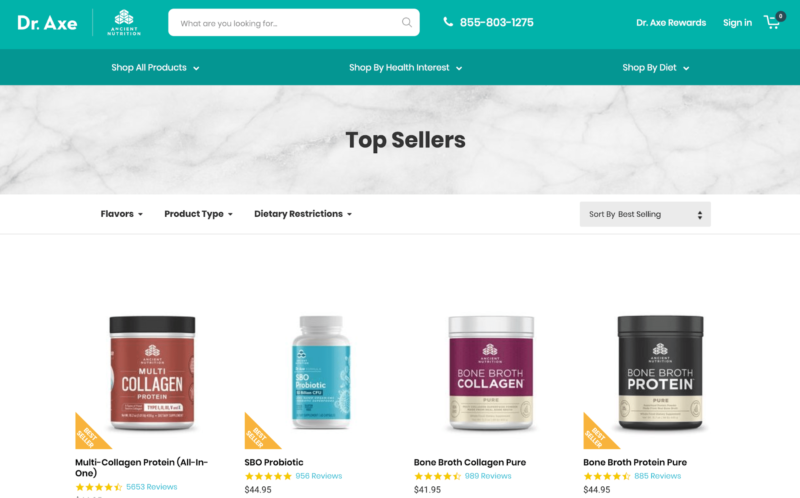
I did hear that they have a solid paid marketing engine going for their funnels. If that’s true, they could be doing easily $50–70 million per year by now.
I consider Dr. Axe to be a great example of what a health and fitness blog looks like when taken to its absolute height. If you’re considering a health and fitness blog, I’d study Dr. Axe closely
Peter Adeney — Mr. Money Mustache
Revenue = About $400,000 per year
According to this article from the New Yorker, Peter pulled in about $400,000 per year as of 2016. Ahrefs reports that Peter’s traffic has been static since the 2016 period. If that’s true, I would expect his current revenue to be around $400,000. Sounds like the majority of the revenue, possibly even all of it, comes from affiliates.
AJ Harbinger and Johnny Dzubak — Art of Charm
Revenue = My guess is $5–10 million per year
Jordan Harbinger didn’t reveal exact revenue but did say that it’s multiple seven figures per year. Based on the fact that the revenue is mostly infoproducts and the overall size of the audience, my guess is that Art of Charm does $5–10 million per year in revenue.
In 2018, Jordan Harbinger split from the Art of Charm and started his own podcast.
Pat Flynn — Smart Passive Income
Revenue = $2,171,652 per year
Pat Flynn posts all his income reports here, going back all the way to 2008.
Not sure if Pat decided to stop but it doesn’t look like he’s posted any new income reports since 2017. Regardless, I highly recommend reading through the first few years of income reports from Pat. That’ll give you a strong sense of what it takes to start making money with a blog.
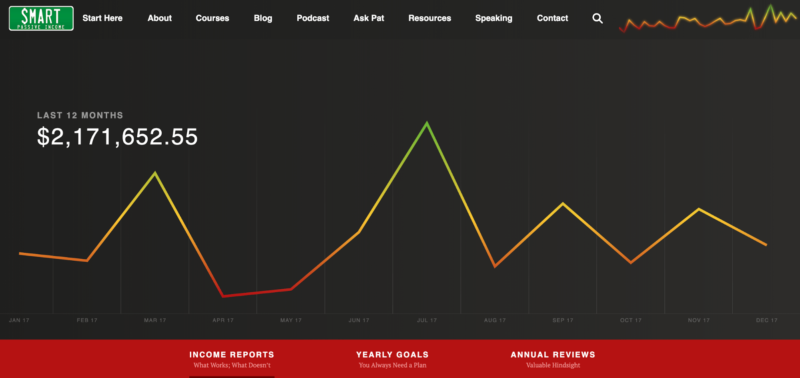
The majority of Pat’s revenue comes from affiliate offers and his own infoproducts, about 50/50 between the two. He also has a few books published, How to Be Better at Almost Everything and Will it Fly? Other than the months he received the advance from the publisher, I bet these books have a negligible direct impact on revenue.
John Lee Dumas — Entrepreneur on Fire
Revenue = $2,029,744 per year
No one really needs to guess at John Lee Dumas’ revenue, he posts monthly income reports directly to his site.
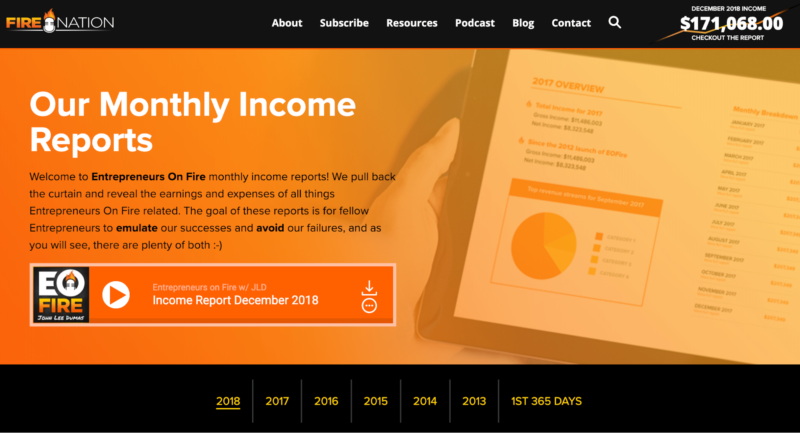
He also put together a nifty revenue breakdown by source:
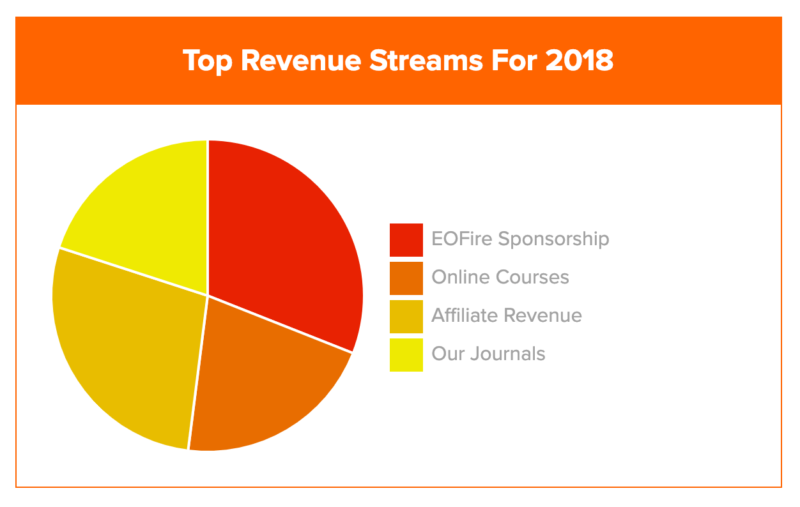
Sponsorships are slightly larger than everything else. Otherwise, it’s a pretty even split between infoproducts, affiliates, and his journals (The Freedom Journal, The Mastery Journal, and The Podcast Journal).
To get a sense of how blogs really make money, I highly recommend you read through the monthly income reports from the last 12 months for Entrepreneur on Fire. You’ll get an excellent feel for what a seven-figure blog looks like. I also recommend you read through the income reports from 2012 and 2013, which will show you what revenue looks like at the beginning and how it changes over time on the path to $1 million per year.
Navid Moazzez — navidmoazzez.com
Revenue = My guess is $300–500K per year
Navid is in the online marketing space and offers infoproducts on virtual summits. According to his About page, he’s earned over $1 million dollars in “a few years.” Safe to say he’s easily doing six figures off his blog. Hence my guess above.
Tim Urban — Wait But Why
Revenue = At least $100,000, possibly $1+ million per year
Tim Urban became VERY popular with his posts being shared all over the internet.
This is probably an example of what most people dream of when they start a blog. They plan to write a bunch of stuff, a rabid fan base will appear out of nowhere, they’ll offer some t-shirts, posters, and a Patreon account to make tons of passive income. They’ll finish by riding into the sunset of eternal blogging glory.

For Tim Urban, that’s basically what happened. And he absolutely deserves it. His content is phenomenal. It’s so good that people have been angry because he hasn’t posted in a while. Very few of us can write content that good. I can promise you no one gets upset when I stop blogging. So for us mortals, we should look to some of the other examples on this list for how to monetize our blogs.
I know that I gave a really broad range on the revenue here. Blogs like this are really tough to guess. Tim clearly has a massive, adoring audience. That doesn’t necessarily mean he’s swimming in gold. Although he might be. Blogs with massive audiences like this sometimes make a ton of money, and sometimes they make very little. It also looks like his main source of revenue is his ecommerce store. Unlike consulting, speaking, infoproducts, or affiliates, the margins on ecommerce products are much smaller. It’s entirely possible that he’s making a ton of top-line revenue but only enough profit to live a decent lifestyle.
That’s pretty common with ecommerce entrepreneurs. They claim that they’re making millions of dollars with their business but only take home $50–100K per year. Once you factor in the costs of goods sold and overhead, there isn’t a ton leftover. I have no idea if Tim Urban falls into this bucket. I simply don’t know.
Noah Kagan — OkDork, Sumo, and AppSumo
Revenue: $10M last year and growing
Noah’s business is based around four complementary sites:
- Sumo.com: Free marketing tools to grow your business
- AppSumo: Groupon for geeks
- KingSumo: Giveaway web app or WordPress plugin
- BriefcaseHQ: Netflix for business software
This system of related businesses is one of his tips for growing a successful business. He thinks of these businesses like a pyramid — KingSumo helps grow your business with giveaways, Sumo (which is the core product) arms those businesses with the tools they need for marketing, and BriefcaseHQ and AppSumo provide the rest of the tools. Creating a system of interlocking tools means you don’t need to find new customers; you can simply market to the customers you already have.
This reminds me of Target adding in groceries. They increased their revenue by asking, What are our existing customers buying that they aren’t buying from us? What do they need that I could sell them?
Noah has an even better analogy: it’s like buying another book from an author you already love. If you love a book an author’s written, of course, you’re going to but their next book and their next book.
He’s also got a lot of thoughts on setting the right pricing structure, leveraging recurring revenue, and bundling that’s all worth studying as well.
Shane Parrish — Farnam Street
Revenue: It’s all been reinvested into the business, plus speaker fees
Shane started his blog to track his own personal learning and development — he didn’t have any grand ambitions for the project, and the original URL, 68131.blogger.com, shows it. Today his newsletter has 200,000 subscribers and Farnam Street gets 1M pageviews a month.
How does he make money? Well, “earn money” vs. “make money” is a good distinction here. Shane says he’s reinvested most of the money back into the business, “In 2014, I think we actually lost money. In 2015, we didn’t lose money, which was good. … I will say that I’ve never actually personally made a penny off Farnam Street. It’s all been reinvested back into content, experience, trying new things, and that’s the way that hopefully I foresee the future.”
He makes money in a variety of ways: he first paid his expenses with Amazon affiliate links, then in 2014 he started his first 9-month partnership deal, newsletter sponsorships, conferences, speaker fees, infoproducts, a podcast, a forthcoming book, and a membership plan for his site that you can choose what you pay, currently either $149 or $249. His model is based on providing free content to many and creating a base of super fans who’ll pay for more of that content, subsidize the free content to give back, and gain access to even more: a book club, a discussion group, and private Ask Me Anythings. If 5% of his 200,000 newsletter subscribers convert (that’d be 10,000 members), and each of them signed up at the $149 level, that’d be $1.5M a year.
Shane regularly turns down speaking engagements for $20,000 because it’s not how he wants to make money, and he doesn’t optimize his in-person workshops for revenue. He’s always asking what’s in the best interest of the business. That means the bulk of the revenue comes from memberships.
I agree with his advice: “The audience will grow if you put out good content.” And, “I know how easy it is for people to copy our content and even our business model. So that drives a lot of what we do. We want to do things that are hard to copy and that means we can’t cherry-pick what’s easy, because there is a lot of competition in easy.”
Ready to build a blog that makes money?
I know the list above is full of people making serious money.
Here’s the crazy part.
For every blogger making a million dollars, there are thousands that make enough money to quit their job and work on their blog full time.
The list is too long to keep track of — I wouldn’t be able to put it together.
It is absolutely reasonable to start a blog with the goal of quitting your job and being your own boss. So many people have already done it you’d be walking a well-traveled path at this point.
I also believe that there’s still a ton of opportunity to be made blogging. I see new up-and-coming bloggers every year. It’s still possible to start a blog today and have it support you. I put together a 12-step guide on how to start a blog here. It’ll walk you through the whole process.
from Quick Sprout https://ift.tt/2GRkpEw
via IFTTT


